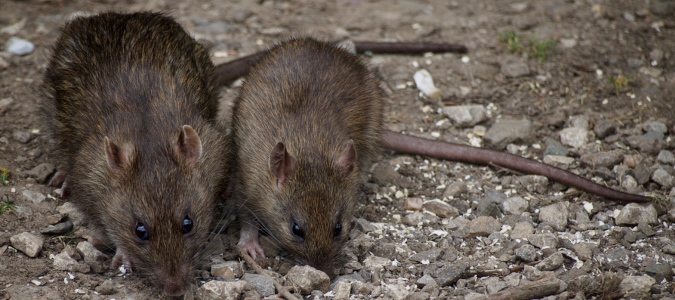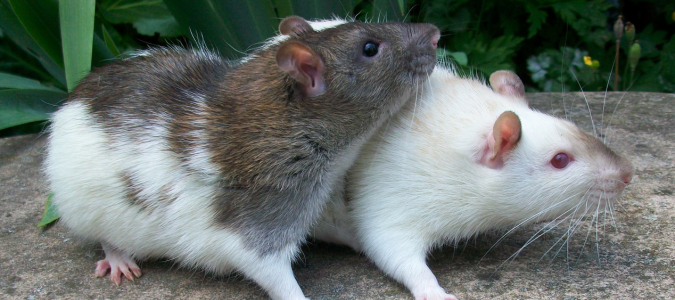Rats are acrobatic creatures that can squeeze through tiny spaces, which leaves many homeowners asking if they have bones. The answer is yes, they do have bones. However, their bodies have a unique structure that gives them special skills.
Do Rats Have Bones?
Just like any other vertebrate animal, rats do have bones. However, it’s common to question if rats have bones because they are extremely agile and flexible creatures. They can bend and manipulate their bodies to fit through tiny holes and cracks.
If you’ve ever seen a rat squeeze through a tiny opening, you understand it’s an impressive feat. They easily fit through holes that seem way too small for their bodies. Rats only need an opening to be the size of a quarter, about an inch wide, to fit through it.
It may look like rats don’t have a skeletal structure, but the truth is that they have a spinal system and bones just like other mammals.
When necessary, their hinged ribs can collapse, and their spines can bend and twist into various shapes to help them fit through tiny openings. Essentially, rats are small contortionists. They also have strong front legs that they use to pull themselves through the opening.
Because of their unique abilities, inspecting your home for tiny openings that rats could use to enter through is crucial. For example, inspect for cracks in your home’s foundation, holes in your vents or gaps around your pipes.
Rats are smart, agile and sneaky, and the last thing you want is for rats to take up residence in your home. Rats are skilled at going unnoticed, and due to their rapid breeding, a small infestation can quickly turn into a large one.
How to Prevent Rats From Entering Your Home
Once you understand how easily rats can fit through small holes, you should prioritize making your home less friendly to rats. Start by thoroughly inspecting your home and identifying all potential rat entry points.
Seal up all cracks and gaps around your doors, windows and along the foundation. Rats have powerful teeth but cannot chew through metal, so it’s a good idea to use steel wool and caulk to seal up the openings.
Next, check around your vents and pipes. Gaps and holes around your utility lines are easy for rats to access from the exterior of your home. You can block access by using a mesh screen or foam insulation.
You can also fill gaps around your doors by using door sweeps and weather stripping. Tiny cracks around your doors can become easy access for rats, so this is an important area to pay attention to and fix.
Contact a pest control specialist to find all the potential rat entry points around your home. An expert can easily identify tiny openings that you may have missed and help you put other prevention measures in place to help you avoid an unwanted rat infestation.
Can Rats Squeeze Under Doors?
Did you know that rats can squeeze underneath doors? Even if a door seems closed, these uninvited guests can often squeeze through small gaps underneath. It doesn’t take much room for them to slip into different rooms, spreading wherever they find entry points.
These pests are nocturnal creatures who prefer to move around at night, so it’s unlikely that you’ll actually see a rat entering through your doors. Interestingly, even though they are nocturnal, rats do not see well at night. However, poor vision does not stop them from trying to get into your home.
If there are small gaps under your doors, rats can easily squeeze through them. They only need an inch of space, or the size of a quarter, to squeeze under your door and enter your home.
If an entry point isn’t big enough, rats will use their sharp teeth to make it bigger until they can squeeze through it. These pests are known for gnawing through tough materials and causing significant property damage. They can chew through wood, plastic and rubber.
How To Keep Rats From Squeezing Under Doors
There are a few ways to keep rats from squeezing under your doors. First, install door sweeps to close the gap between your door and the ground or floor. A metal door sweep is the best because rats cannot chew through metal.
Next, inspect your doors to make sure they have proper weather stripping. This is especially important with doors that lead to your basement or garage, as these are popular rat nesting areas. Along with keeping pests away, installing weather stripping on your doors can also improve insulation.
Another area to inspect is your door frames. Rats can squeeze through small openings and cracks and gnaw through your door frame to make the openings bigger. Use metal mesh or caulk to block their access.
For more rat prevention techniques, contact a pest control service. The professionals will go the extra mile to help you prevent a rat infestation. If you already have a rat infestation, using professional services is the best way to control it.
How Many Rats Can Live in a Rat Hole?
Have you spotted a rat hole around your property and wondered how many rats can live there? The answer is that typical rat holes are home to a single rat family, which includes a male rat, a female rat and up to twelve of their rat babies.
However, with large infestations, more than one rat family may live in a rat hole at a time. If the rat hole has easy access to food, water and shelter, it may house several families and dozens of rats.
What Do Rat Holes Look Like?
Homeowners should understand what rat holes look like to identify them on their property. Most rat holes are between two and four inches wide.
You may spot them around the foundation of your home or other buildings on your property, in your gardens, near a shed or around your garage. Rats prefer to dig holes in undisturbed areas such as in bushes, behind walls and under decks. Rats like to eat a variety of foods, so they spend their waking hours scavenging. They often dig their holes near food sources.
Rat holes look well-worn around the entrance because multiple rats go in and out throughout the night. Due to its frequent use, the dirt around the hole will look smooth and compacted. If the hole is new, you may see loose dirt around the entrance. This is the dirt that the rats dug up to create the opening.
Rat holes look shallow from the surface, but they can extend several feet into the earth. Rats build impressive underground dwellings with multiple chambers and exits.
A telltale sign that a rat hole is nearby is a visible path to the entrance. Rats traverse the same path repeatedly as they move from their shelters to their food sources, leaving behind tracks and rub marks.
If you spot a rat hole on your property, it’s important to act quickly, as multiple rat families could live there. A small rat infestation can quickly become a large problem and cause major frustration for homeowners.
Do not try to block the rat hole or deal with it yourself. Blocking the hole will only encourage rats to dig a new hole elsewhere.
A better way to address the problem is to look for their food sources and remove them. Rats love scavenging through trash to find food, so ensure your outdoor trash bins have tight-fitting lids. You should also store pet food indoors, especially at night, when rats are active.
The most effective thing you can do is call in a pest control service. The experts can remove the rat population for you, seal up the rat holes and put prevention methods in place to help deter rats in the future.
Get Rid of Rats With Professional Help
Are rats wreaking havoc on your property? The most effective and efficient way to deal with a rat problem is with help from pest control professionals.
ABC Can Help With Any Pest Problems
It can feel frustrating when rats infest your property. Instead of spending your time trying to get rid of rats on your own, contact ABC Home & Commercial Services. Our experts will be able to control the rodents on your property. We will create a custom pest treatment plan, so you don’t have to worry about these creatures.



